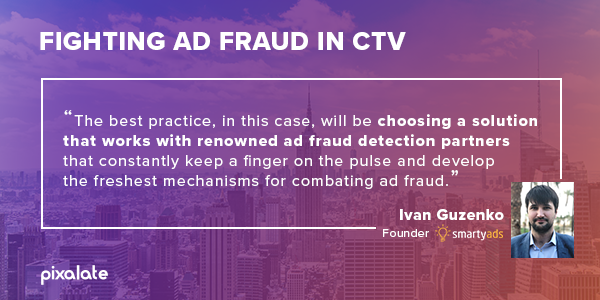

Pixalate spoke with Ivan Guzenko, Founder of SmartyAds, about combatting invalid traffic (IVT) and ad fraud within the rising Connected TV (TV) programmatic ad ecosystem.
About Ivan Guzenko:
Ivan Guzenko, founder of SmartyAds, is a tech-minded entrepreneur, ad tech and mar tech expert. He also holds the position of CPO at SpearAd, a Programmatic TV platform.
His in-depth knowledge and startup raising experience allowed him to get in on the ground floor of innovative technologies, collaborate with like-minds, and gather immense knowledge that he shares in conferences like Dmexco, MWC.
Guzenko is an active industry thought leader and contributor to Forbes, Entrepreneur, and Inc. Pixalate spoke with Guzenko about battling ad fraud in CTV programmatic advertising.
See the full Q&A below:
Guzenko: SmartyAds works with plenty of advertisers who seek strong, connected TV advertising capabilities and collaborates with renowned partners that generate solid traffic volume in this niche. Additionally, SmartyAds does the utmost to strengthen its day-by-day CTV capabilities, successfully matching advertising demand with reliable supply from publishers.
Guzenko: Previously, SmartyAds tried to collaborate with various traffic safety providers and implemented in-house safety tools for regular traffic quality monitoring on all mediums, including CTV. This was a period of a try-and-test approach, during which we pinpointed what worked best for us and safeguarded the ad ecosystem from head to toe.
A collaboration with Pixalate turned out to be the optimal decision for us, as their traffic scanners incorporate the latest anti-fraud mechanisms that effectively detect and prevent ad fraud on a post- and pre-bid basis.
Guzenko: When it comes to our own in-house traffic safety tools, we should say that they have a multilayered system of ad fraud detection. We have a team, involved in constant traffic monitoring, that also sticks to the established internal rules and procedures of traffic verification. In order to assess the quality of the traffic source, the team typically uses:
Guzenko: The viewership, as well as ad spending on CTV, has drastically increased during the last few years. Because of this, this medium attracts many publishers and becomes difficult for advertisers to clearly understand campaign performance, perform consistent attribution, and prevent ad fraud.
When anti-fraud standards, identifiers and metrics for CTV measurement become universal for all platforms, CTV campaign planning and management will be much easier.

Guzenko: Ad fraud is not standing still - it has been developing with enormous speed, especially during the last year, when ad budgets were massively distributed towards connected TV (during lockdown, TV watching time grew significantly).
For advertisers, it is nearly impossible to remain 100% sure that their ad budgets are not wasted on fraudulent impressions. The best practice, in this case, will be choosing a solution that works with renowned ad fraud detection partners that constantly keep a finger on the pulse and develop the freshest mechanisms for combating ad fraud.
Guzenko: Connected TV is a relatively new medium, which is why it could be correct to say it still hasn’t matured. The big market players need a better understanding of how this technology works and how advertising on CTV impacts their advertising outcomes, as well as sales and revenues.
As soon as this understanding comes, we will see massive adoption of CTV, as leaders will set the pace and the rest of the market will follow. As a result, the connected TV advertising medium will rapidly evolve, conveying even more effective brand-customer communication that will contribute to great advertising outcomes.
*By entering your email address and clicking Subscribe, you are agreeing to our Terms of Use and Privacy Policy.
These Stories on Case Studies
*By entering your email address and clicking Subscribe, you are agreeing to our Terms of Use and Privacy Policy.

Disclaimer: The content of this page reflects Pixalate’s opinions with respect to the factors that Pixalate believes can be useful to the digital media industry. Any proprietary data shared is grounded in Pixalate’s proprietary technology and analytics, which Pixalate is continuously evaluating and updating. Any references to outside sources should not be construed as endorsements. Pixalate’s opinions are just that - opinion, not facts or guarantees.
Per the MRC, “'Fraud' is not intended to represent fraud as defined in various laws, statutes and ordinances or as conventionally used in U.S. Court or other legal proceedings, but rather a custom definition strictly for advertising measurement purposes. Also per the MRC, “‘Invalid Traffic’ is defined generally as traffic that does not meet certain ad serving quality or completeness criteria, or otherwise does not represent legitimate ad traffic that should be included in measurement counts. Among the reasons why ad traffic may be deemed invalid is it is a result of non-human traffic (spiders, bots, etc.), or activity designed to produce fraudulent traffic.”

